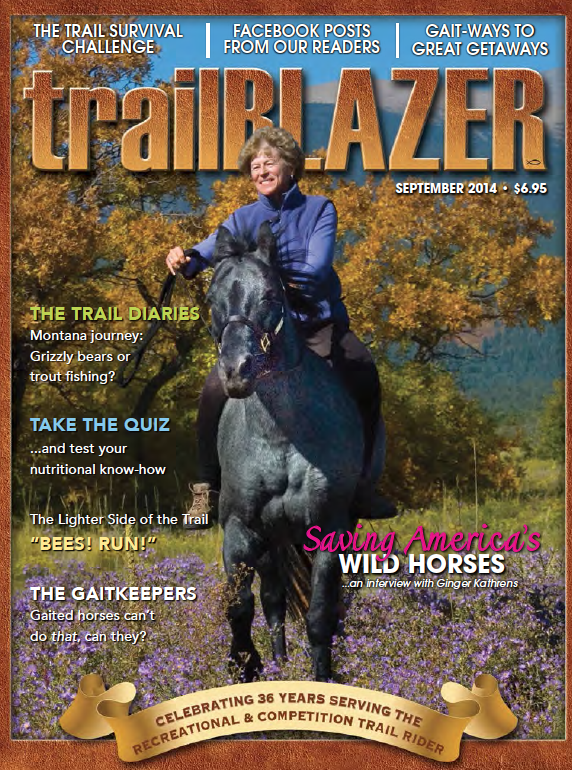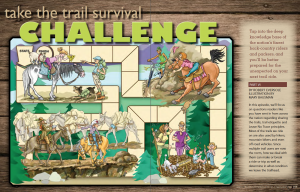 Survival Challenge – Sharing The Trails
Survival Challenge – Sharing The Trails
This episode we’ll be focusing on the questions readers like you have sent in from across the nation regarding sharing the trails, trail etiquette, and even Leave No Trace. Most of the trails that we travel are also used by hikers, mountain bikers, and even off road vehicles. Since multiple users on the trail is the norm, how we deal with them can make or break a ride or trip as well as in what condition we leave the trailhead.
Let’s start off with sharing the trail. In my trail travels I frequently cross paths with other trail users and by and large these encounters are usually friendly and at worst merely cordial; we get along great and enjoy each others company and experiences. Let’s hear from a few riders who have not had such pleasant meetings.
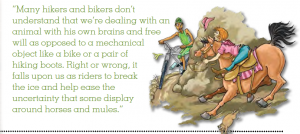 Q – I was riding and a biker spooked my horse. What should I have done? Yours truly, No Rollers
Q – I was riding and a biker spooked my horse. What should I have done? Yours truly, No Rollers
A bicyclist silently hurtling around a blind corner and suddenly encountering me and my horse. It’s a frequent nightmare of mine, and I’m sure a large number of other horse and mule riders. What can we do when a biker wearing a Darth Vader helmet suddenly screeches to a halt directly in front or behind our startled mount?
A. Give back what you got and spook the biker right back.
B. Report him to the park ranger
C. Start a conversation with the biker as soon as you see him
D. Start exposing your horse to bicycles at home
One of my greatest safety concerns includes thoughtless encounters between bikes and horses. Bikes are often hurtling down the trail and some horses move pretty darn fast as well. It’s the speed of the encounter that becomes the root cause of the problem here.
In this situation hopefully you’ve taken “D” to heart and the spook was mild at worst. “C” will generally prevent a worse situation, as the sound of a human voice will let your mount know that this spandex clad apparition is human and benign.
As equine enthusiasts we know and understand that horses are prey animals whose first instinct is to flee at great speed whenever they perceive a threat. We’re quite fortunate to have this knowledge because the vast majority of people today don’t have any relationship with large animals and they just don’t know how to behave around livestock. It’s up to us to help educate other trail users while also preparing ourselves and our mounts to handle the unexpected.
Backcountry Horsemen of Washington member; Everett Lewis has created a wonderful video to help educate bikers, hikers, and horse folk after his wife took a nasty tumble when a bicyclist thought he was doing the right thing by being very quiet as he passed. Luckily she walked away, shaken but not mortally stirred. You can find the video at this web address (https://trailmeister.com/what-a-horse-sees/) and I whole heartedly recommend that everyone both watch and encourage others to do so as well. The life you save may be your own.
Everett has distilled the myriad of items that should happen when we meet another trail user into three easy to remember steps that we can share with the growing number of people that we meet on the trail.
1. STOP – Horses spook easily, and may perceive movement, especially quiet movement, as a predator.
2. TALK – Human speech is reassuring and comforting for the horse. Continue the conversation until both parties have passed.
3. MOVE DOWN – Move to the low side of the trail. If horse gets spooked, it will most likely move uphill.
As good riders we must proactively expose our horses to as many distracting situations as possible to de-sensitize our mounts to these potentially scary sights. A properly trained mount that has been exposed to a wide variety of situations is less likely to blow up. That being said any equine can and will spook despite our best efforts and we must be ready for a rodeo especially when riding in areas where there are many other trail users.
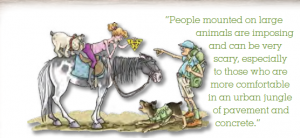 Q – I told a hiker they had to get off the trail for me to pass on my horse and she made rude comments. What should I do? Truly yours, BootsnAll
Q – I told a hiker they had to get off the trail for me to pass on my horse and she made rude comments. What should I do? Truly yours, BootsnAll
I think we can all agree that there are always the “1 percent” of people that live life with a chip on their shoulder. So what can we do when we encounter one of these rude individuals?
A. Ignore her and ride on
B. Ask her nicely and let her know that stepping aside is for her own safety
C. How rude! It’s time to give her a piece of your mind!
D. Put yourself in the hikers boots and consider what she may be feeling
Anger is often rooted in fear. As horse and mule riders we’ve been blessed with having a close connection with livestock. Most hikers and bicyclists haven’t had the benefit of the rich lives that we lead. Not only does the average trail walker, or roller in the case of bicycles, not have a clue about how to safely interact with equestrians, they are intimidated by us. People mounted on large animals are imposing and can be very scary especially to those who are more comfortable in an urban jungle of pavement and concrete. Once we accept the fact that we can be scary to others we can start to understand why they won’t start a conversation or perhaps are a bit stand offish.
Many hikers and bikers don’t understand that we’re dealing with an animal with its own brains and free will as opposed to a mechanical thing like a bike or a pair of hiking boots. Right or wrong it falls upon us as riders to break the ice and help ease the uncertainty that some have around horses and mules.
In this situation I would take “D” to heart and explain “B” in the most pleasant, sugar coated, manner that I could muster.
The triangular trail courtesy signs that we often see are sometimes wrongly interpreted as one user group having greater importance than another. If we remember that instead they are only recommendations based upon what is generally the safest way of meeting and passing another trail user we may find that our interactions become much more pleasant.
When I encounter another trail user I’ll give way if it’s safe to do so regardless of what the sign says. Doing so allows me to have control of the situation and choose the safest place for the hiker or biker to pass by. Common sense and courtesy are much more important than who may have the right of way.
Anger rooted in fear affects horse folk as well. I once had the misfortune to ride with an inexperienced rider who was so ill at ease with other user groups on the trail that she would literally yell commands at the bikers and hikers we met. Needless to say we didn’t encounter many happy smiling faces and I don’t think equestrians in general were well represented that day. The issue that day was a problem that the equestrian needed to fix, not the other trail users.
In summary, don’t preach the rules of the trail, and please don’t yell. Instead consider that the hiker may be afraid, ask nicely, and you’ll most likely get cooperation.
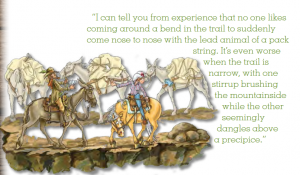 Q – I’m afraid of turning my horse around on tight trails but I was told I have to yield to a pack string. What do I do? Yours, Lone Rider
Q – I’m afraid of turning my horse around on tight trails but I was told I have to yield to a pack string. What do I do? Yours, Lone Rider
This is a scenario that backcountry riders deal with on a regular basis and one that gives even the most seasoned of us fits at times. I can tell you from experience that no one likes coming around a bend in the trail to suddenly come nose to nose with the lead animal of a pack string. It’s even worse when the trail is narrow with one stirrup brushing the mountainside while the other seemingly dangles above a precipice. How would you handle this frightening situation?
A. Ride a mule and don’t sweat it.
B. Back your horse out – very carefully
C. Ask the packer politely for their patience while you dismount and turn your horse around.
D. Prepare yourself and your animal to turn on tight trails before you venture into these areas.
As recreational riders it’s not just hikers and mountain bikers that we need to be considerate of. In many areas pack strings are common sights as they make their way to and from destinations deep in the backcountry. How we handle our encounters with pack strings and other groups of horse riders will make or break a good ride.
Let’s consult a long time packer for this question. Betty Applebaker of the Oregon Backcountry Horsemen with her husband Dan, is one of the driving forces behind the annual Wilderness Skills Clinic in Klamath Falls Oregon. With decades of packing experience behind her as a Forest Service packer, Betty is a wealth of information.
As much as I appreciate the veracity of “A” Lone Rider will be best served by “D” and preparing for these encounters long before he visits the backcountry. Negotiating encounters with other groups of horses can be interesting at best. However, just as we saw with hikers and bikers, common courtesy will guide the way. If we think we have our hands full when riding a single horse consider the plight of the packer who has not only her riding mount but also a slew of pack animals strung along behind to concern her. It’s much easier and safer for a single rider to make way for the larger group as well as creating less impact off trail.
Turning around on a narrow trail isn’t fun but with practice it can become much more tolerable. Depending upon trail conditions it’s usually best to turn to the downhill side so that your animal is better able to watch where he places each hoof, making the chance of a slip much less.
Alternatively, there is no shame at all in dismounting and turning your animal. If you select this option it is generally safer to be on the downhill side so that you won’t slide under your horse should you slip (after all you don’t have the 4×4 traction that your horse has). Should you choose this option you may have to lead your animal to a safe spot where you can safely remount before proceeding on.
If you plan on riding on where the trails are tight prepare beforehand for the eventuality of having to turn around. You’ll be glad you did.
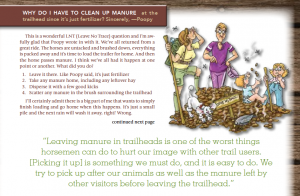 Q – Why do I have to clean up manure at the trailhead since it’s just fertilizer? Sincerely, Poopy
Q – Why do I have to clean up manure at the trailhead since it’s just fertilizer? Sincerely, Poopy
This is a wonderful LNT (Leave No Trace) question and I’m awfully glad that Poopy wrote in with it. We’ve all returned from a great ride. The horses are untacked and brushed down, everything is packed away and it’s time to load the trailer for home. And then the horse passes manure. I think we’ve all had it happen at one point or another. What did you do?
A. Leave it there, like poopy said it’s just fertilizer
B. Take any manure home, including any left over hay
C. Disperse it with a few good kicks
D. Scatter any manure in the brush surrounding the trailhead
I’ll certainly admit that there is a big part of me that wants to simply finish loading and go home when this happens. It’s just a small pile and the next rain will wash it away right? Wrong.
I asked Betty about her thoughts on this as a former Forest Service packer and her response was “leaving manure in trailheads is one of the worst things horsemen can do to hurt our image with other trail users. It is something we must do and it is easy to do. We try to pick after our animals as well as the manure left by other visitors before leaving the trailhead.”
I agree wholeheartedly with Betty on this subject. “B” is the best answer with “D” being a distant second. While we may not think about it, we’re not the only people using the trail, nor are we the only equestrians using the trailhead. Add the contents of your one small pile to the next rider’s small pile and you can see how quickly the affects accumulate. Soon the whole lot is covered in a huge mess that can easily become a valid reason for the land manager to restrict equine access.
Set a positive example for other horsemen by picking up your animal’s manure and taking it home with you if the trailhead doesn’t have manure collection facilities. Although we may have been inurned to the sights and smells of our horses deposits it is unsightly and annoying to other trail users.
Until the next time please help set a positive example for horse and mule riders by sharing the trail and keeping our trailheads clean.
With that we’d better wrap up this edition of The Trail Survival Challenge. Do you have a trail riding question that you’ve been aching to learn more about? Have you wondered if you did the right thing in a certain trail experience? Send us your questions and we’ll see what the best horsemen in the world have to say.


